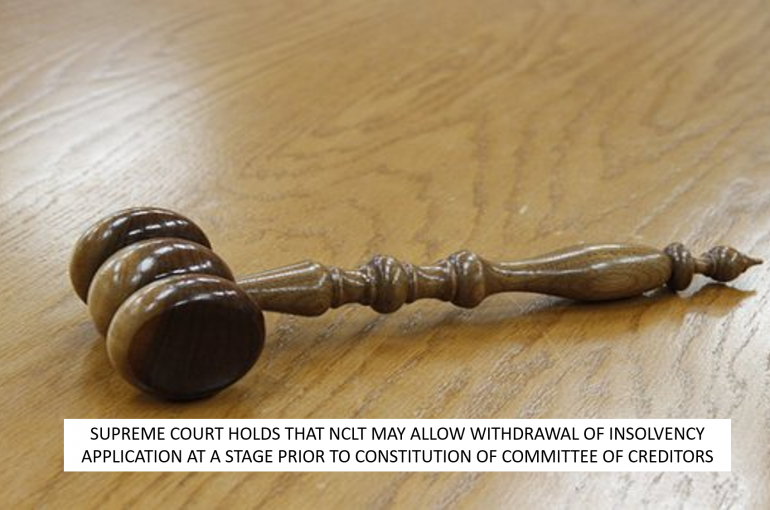SUPREME COURT HOLDS THAT NCLT MAY ALLOW WITHDRAWAL OF INSOLVENCY APPLICATION AT A STAGE PRIOR TO CONSTITUTION OF COMMITTEE OF CREDITORS
Recently, a two-Judge Bench of the Supreme Court comprising Justice B.R. Gavai, and Justice Vikram Nath passed a judgment dated 28.03.2023 in Abhishek Singh V Huhtamaki Ppl Ltd. & Anr in Special Leave Petition (Civil) No.6452 Of 2021, and observed that the National Company Law Tribunal (NCLT) may allow withdrawal of Corporate Insolvency Resolution Process (“CIRP”) applications under Section 12A of the Insolvency and Bankruptcy Code, 2016 (“IBC”), at a stage when (i) the CIRP has been initiated, (ii) the Interim Resolution Professional has been appointed, (iii) but Committee of Creditors (“CoC”) has not yet been constituted.
FACTS
A company named, Manpasand Beverages Ltd. (“Corporate Debtor” or “CD”) is engaged in the business of manufacturing and distribution of fruit beverages. One, Huhtamaki PPL Ltd. (“Operational Creditor” or “OC”) used to supply packaging material to the Corporate Debtor. The Appellant, Abhishek Singh, is a suspended Director of the Corporate Debtor. The Operational Creditor filed a Petition under Section 9 of IBC (Application for initiation of corporate insolvency resolution process by operational creditor), seeking initiation of CIRP in respect of the Corporate Debtor, over a default of Rs.1,31,00,825/- in NCLT, Gujarat. The NCLT vide Order dated 01.03.2021 admitted the said Petition and initiated CIRP in respect of the Corporate Debtor. Within two days of initiation of CIRP, the Corporate Debtor and its operational creditors entered into a Settlement dated 03.03.2021 (Settlement) wherein the CD was required to pay a total amount of Rs. 95.72 Lakhs to all its operational creditors. The above Settlement was arrived at even before the Committee of Creditors (CoC) could be constituted.
The Interim Resolution Professional (IRP) on 10.03.2021 moved an Application before NCLT, Gujarat under Regulation 30A of the Insolvency and Bankruptcy Board of India (Insolvency Resolution Process for Corporate Persons) Regulations, 2018 (Regulations) (Withdrawal of Application) seeking withdrawal of CIRP against the CD. The Appellant also filed an Application under Section 12A of IBC for withdrawal of CIRP.
In the meantime, the Corporate Debtor had filed an Appeal before the National Company Law Appellate Tribunal (“NCLAT”) against the NCLT Admission Order dated 01.03.2021, which was withdrawn, with liberty to revive the appeal in case the settlement failed. The NCLAT also stayed the formation of CoC till the NCLT decides the Application under Section 12A of IBC.
The NCLT vide impugned judgment and Order dated 13.04.2021 (i) rejected the Appellant’s Section 12A – IBC Application and (ii) further, fixed the matter for disposal of the IRP’s Application under Regulation 30A, after hearing all the creditors. Further, the NCLT observed that Regulation 30A was not binding upon NCLT and such provision would not be of any help to the Corporate Debtor or its Suspended Directors. Subsequent to the above Order of NCLT dated 13.04.2021, the IRP constituted the CoC on 15.04.2021.
REASONING AND ANALYSIS
Aggrieved by the aforementioned Order dated 13.04.2021 of the NCLT, the Appellant moved the Supreme Court under Article 136 of the Constitution of India (Special Leave to Appeal by the Supreme Court).
The Apex Court relied on the judgment Swiss Ribbons (P) Ltd. V. Union of India, (2019) 4 SCC 17, wherein it was held that NCLT may invoke its inherent powers under Rule 11 of NCLT Rules, 2016 to allow/disallow an application for withdrawal or settlement, when CoC has not been constituted.
In the present case, the Supreme Court observed as follows:
“The Board was conferred with powers to frame regulations for various purposes referred to in section 240 of IBC and the other allied sections. These regulations may be subordinate in character but would still carry a statutory flavor and would be binding on the NCLT. The NCLT committed an error in holding that Regulation 30A would have no binding effect. This would amount to defeating the very purpose of substituting Regulation 30A in IBBI Regulations on 25.07.2019 after the judgment of Swiss Ribbons(supra) which was dated 25.01.2019.”
The Apex Court further held that Section 12A – IBC permits withdrawal of applications admitted under Sections 7 (Initiation of corporate insolvency resolution process by financial creditor), 9 and 10 (Initiation of corporate insolvency resolution process by corporate applicant) of IBC. The approval of 90% of CoC members would be required when withdrawal is being made after constitution of CoC. However, Section 12A – IBC does not debar entertaining applications for withdrawal even before constitution of CoC and thus the present Section 12A Application cannot be kept pending for constitution of CoC.
The Supreme Court held as follows:
“The IBBI which had the power to frame Regulations wherever required and in particular section 240 of IBC for the subjects covered therein had accordingly substituted Regulation 30A dealing with the procedure for disposal of Application for withdrawal filed under section 12A of IBC. The substituted Regulation 30A of IBC as it stands today clearly provided for withdrawal Applications being entertained before constitution of CoC. It does not in any way conflicts or is in violation of section 12A of IBC. There is no inconsistency in the two provisions. It only furthers the cause introduced vide section 12A of IBC. Thus, NCLT fell in error in taking a contrary view”
Conclusion
Thus, based on the aforesaid observations, the Supreme Court held that the inherent powers are to be invoked by NCLT in order to meet the ends of justice, which in this case, the NCLT failed to do so. As a result, the Apex Court allowed the Appeal, set aside the NCLT Order dated 13.04.2021 and further allowed the IRP’s Withdrawal Application filed under Regulation 30A.
Devashish Kakkar
Legal Associate
The Indian Lawyer





































Leave a Reply